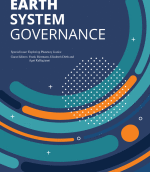Persistent ecological and socio-economic impacts from the expansion of industrial monocultures in the tropics have raised land use sustainability to the top of the environmental policy agenda. As major crops such as soy continue to experience growing market demand and threaten both natural ecosystems and traditional populations, a number of multi-stakeholder governance initiatives have been established around agricultural commodity chains or key landscapes. Effectiveness in curbing unsustainable land use, however, remains limited. In this context, innovative initiatives have blurred the lines to combine both supply chain and landscape governance. We analyze such arrangements—here conceptualized as commodity-centric landscape governance (CCLG)—with an in-depth case study of the Cerrado Working Group, a multi-stakeholder initiative led by civil society and the soy agribusiness to address land use change in that savanna landscape in Brazil. The paper examines how that initiative has come about, its agenda, as well as usually underexposed political dimensions using agenda-setting theory. The research is based on extensive fieldwork in Brazil, with data collected through document analysis and 56 key-informant interviews. The findings suggest that a sustainable development agenda for the Cerrado has been substantially narrowed to become mostly one of conversion-free soy supply, serving more the interests of that agroindustry and its consumers than those of the landscape’s most vulnerable stakeholders, such as local communities. While the Cerrado Working Group has importantly broadened the policy scope beyond commodity certification, its limited inclusiveness and a skewed agenda have led to instruments that target only soy farmers as beneficiaries. We conclude that, although effective for targeting conversion drivers, CCLG can crystallize and reinforce existing land use patterns by granting disproportionate power to dominant stakeholders, thus limiting the agenda to incremental changes. As a consequence, distant demand-side actors may exert greater governance authority than the landscape’s own population. If embodying norms of inclusiveness and equitable participation, CCLG may serve as an entry point, but it does not per se replace inclusive land-use planning and integrated landscape governance.
Commodity-Centric Landscape Governance as a Double-Edged Sword: The Case of Soy and the Cerrado Working Group in Brazil
Bastos Lima, Mairon. G., U. Martin Persson. 2020. Commodity-centric landscape governance as a double-edged sword: The case of soy and the Cerrado Working Group in Brazil. Frontiers in Forests and Global Change 3, 27.









